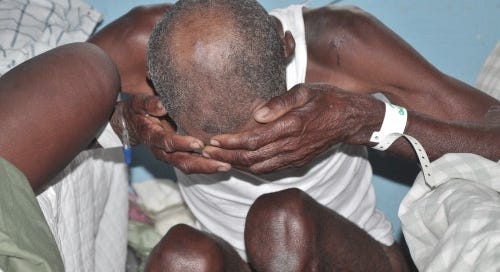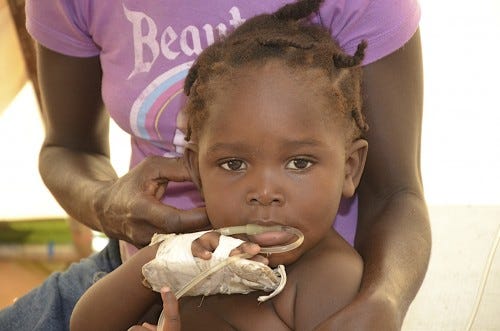Cholera in Haiti, Again
The New England Journal of Medicine—November 30, 2022
Richard P. Wenzel, M.D.
Cholera is a severe diarrheal disease caused by a toxin produced by Vibrio cholerae that leads to life-threatening losses of fluid and electrolytes. According to the World Health Organization (WHO), the gram-negative, curved, rod-shaped bacterium has been responsible for seven pandemics in the past 200 years. The current pandemic began in 1961 with the global spread of the El Tor O1 variant. El Tor (or Al-Tur) is a city on the Sinai peninsula where the variant was isolated in 1905; it had once been the site of an Ottoman quarantine station for pilgrims returning from the Hajj. Today, the variant is estimated to infect 1.3 million to 4.0 million people each year, causing 21,000 to 140,000 deaths.1
Early in my training, I volunteered to manage the care of hospitalized patients with cholera during separate outbreaks in the Philippines and Bangladesh. We clinicians saw as many as 100 patients a day, observing their facial expressions that revealed complete physical and emotional exhaustion, deeply sunken eyes, dry mucous membranes, and remarkable loss of skin turgor. There is no fever with cholera. Most of our patients lost about 10% of their body weight, which correlated with our measurements of a plasma specific gravity of 1.035 or more (normal value, 1.025) and indicated severe dehydration.
With limited resources, simple protocols saved lives: we placed the patient on the canvas cholera cot with a hole for the buttocks above a calibrated collection bucket, infused a quantity of IV fluid based on the patient’s weight (e.g., 5 liters for a patient weighing 50 kg), then kept up with losses by measuring and replacing the ongoing watery discharges containing flecks of cells and mucus (“rice-water stool”). Nearly every patient survived. What kills patients are delays in receiving rehydration therapy.
A new outbreak of cholera anywhere merits our attention. Cholera was visited on the people of Haiti for the first time in 2010, months after the country had weathered a devastating earthquake. The disease’s emergence was traced to infection carried by U.N. security forces from Nepal, where cholera is endemic. The 2010 outbreak had lethal consequences, with an estimated 820,000 cases and 10,000 deaths. Cholera appeared to have been eliminated from Haiti in 2019, only to resurface in 2022.
Now, two timely letters to the editor (both online November 30) provide updates on the resurgence of cholera in Haiti. The letter by Severe et al. outlines the miserable and chaotic social–political situation in Haiti that is aggravating a cholera resurgence and has disproportionately affected undernourished children. The age distribution of people with cholera in the 2010 outbreak was more representative of the entire Haitian population. The risk factors for infection this time around include poor hygiene, lack of safe drinking water, poverty, and malnutrition. Neighborhoods controlled by gangs have no doubt created formidable barriers to early rehydration, and the closing of some hospitals owing to a lack of fuel has limited the options for treating severely dehydrated patients.
In a second letter, Rubin et al. report data from their phenotypic and genetic examination of isolates collected in 2010 and 2022; the findings show strong similarity between these two sets of isolates. Control isolates from a circulating strain in Bangladesh were found to be distinct from the Haitian isolates. The investigators’ findings raise several questions about the resurgence of the same strain after a period without cases: Is the El Tor variant more likely than earlier variants to survive in the brackish waters off Haiti, or more likely to be carried for longer periods by asymptomatic people? What exactly triggered the resurgence? We have no data on population immunity according to age to explain the high proportion of pediatric cases.
Both letters provide insights into a cholera resurgence occurring in a situation of severe social instability, and they are of substantial medical and scientific interest. Moreover, cholera amplified in any community is a threat to communities globally. Even the United States — with its strong medical system, excellent hygiene, and knowledge about rehydration — is at risk for cholera, which could be imported on one of several daily nonstop flights from neighboring Haiti. Few U.S. physicians have experience treating cholera, and the children in our poorest neighborhoods might well be vulnerable.
I don’t think we should wait for cholera to reach U.S. shores before we commit to strengthening public health structures and processes that would allow us to withstand not just a cholera outbreak but also a variety of other unexpected pandemics. Key initiatives might include working to boost vaccine acceptance in general, developing and implementing plans for minimizing poverty and food insecurity, and enhancing access to medical care. At the same time, we need to invest in partnerships aimed at controlling the sources of pandemics in distant countries in order to minimize global spread. These efforts could include the creation of international teams of first responders that are sanctioned by the WHO, the Centers for Disease Control and Prevention, and various governments and are supplied with adequate quantities of IV fluids, antibiotics, and vaccines.
A key lesson from the ongoing Covid-19 pandemic is that science alone cannot control a pandemic. Leadership is essential: decisions need to be made, trust earned, clear messaging preserved, the means of control succinctly articulated, and the public educated and inspired to act. Timing is critical. Early efforts to trivialize the scope of the Covid pandemic in the United States delayed the urgent steps needed to contain it, and we all suffered the consequences.
Pandemics are a natural part of life on a small planet challenged by climate change, harmful deforestation, rapid international air travel, the creation of megacities, civil strife and war, and increasing interactions between people and many nonhuman species. It is likely that these individual crises interact in a way that exacerbates their individual effects. The most worrisome outcome would be a polycrisis — with multiple system failures in the realms of energy, international security, finance, and transportation — that overwhelms the available resources that could enable us to cope.2 Public health and political leaders, in partnerships with other systems experts, need a renewed social contract that entails unusual cooperation, driven by empathy and social values.
The resurgence of cholera in Haiti is yet another reminder that in our closely connected world, we cannot ignore the infectious misfortunes of other countries and the complex interactions among them. It is in our best interest to engage early, offering assistance and expertise, while reexamining our own public health strengths and shortcomings.
—
Resurgence of Cholera in Haiti amidst Humanitarian Crises
TO THE EDITOR:
On October 1, 2022, the Haitian Ministry of Health reported a resurgence of cholera in Port-au-Prince. This comes a decade after Haiti had one of the worst cholera epidemics in modern history in 2010, with more than 800,000 cases and 10,000 deaths. That epidemic was brought under control through a comprehensive response that included cholera treatment; improvements in drinking water, sanitation, and hygiene; case investigation; decontamination of water sources; and oral cholera vaccination of 2.5 million people. The resurgence of cholera coincides with recent political chaos, gang violence, and a blockade of the main port in Port-au-Prince that have led to a catastrophic shortage of food, potable water, and fuel.
As of November 12, 2022, there had been 8257 suspected cases of cholera and 155 deaths from cholera reported, with poor neighborhoods in downtown Port-au-Prince most severely affected. The epidemic has now spread, with suspected cases reported in eight of the ten geographic departments within Haiti.1
Figure 1.
Ages of Patients with Cholera Admitted to the GHESKIO Bicentennaire Cholera Treatment Center during the 2010 and 2022 Epidemics.
GHESKIO, a Haitian nonprofit medical organization, has opened a cholera treatment center in downtown Port-au-Prince. This neighborhood suffers from extreme poverty, poor housing, a lack of clean water, and an absence of sanitation services. The neighborhood is controlled by gangs and is inaccessible to government health workers. Between October 1 and November 12, a total of 556 patients were admitted to the cholera treatment center with suspected cholera, and 494 were tested for cholera. Cultures were obtained in the first 164 suspected cases, and the results in 131 cases were positive. Rapid antigen-detection tests (Crystal VC, Arkray Healthcare) were performed in 330 cases, and the results in 280 were positive. In total, 411 of 494 suspected cases (83%) were confirmed to be positive either by culture or antigen test. Of the 411 confirmed cases, 214 (52%) were in children 14 years of age or younger. In the 2010 epidemic, the age distribution of patients at the same cholera treatment center closely mirrored the age distribution in the general population of Port-au-Prince.3 The age distribution in the current epidemic is markedly skewed toward younger age groups (Fig. 1). The median age of the patients in 2010 was 24 years, as compared with 12 years in 2022.
These early data on the epidemic provide some important insights. This cholera epidemic is disproportionately affecting young children. This may be a result of the children never having been exposed to the bacteria and not having received a cholera vaccine. Furthermore, the United Nations reports that Haiti currently is in a state of level 5, or “catastrophic,” hunger,2 and severe malnutrition is likely to be making children more susceptible to disease.4 Human-made insecurity and fuel shortages are affecting the current resurgence. Without fuel, the national water utility cannot pump potable water from its reservoirs to the most at-risk populations living in neighborhoods characterized by high levels of poverty, and these residents are now forced to drink from contaminated water sources. The garbage trucks in the city cannot pick up trash from the streets. Recent heavy rainfall has flooded downtown areas, including latrines, and has washed even more garbage into the low-lying neighborhoods, further contaminating water sources. Additional details are provided in the Supplementary Appendix, available with the full text of this letter at NEJM.org.
Until the appearance of these recent cases, Haiti had not had a single confirmed case of cholera for more than 3 years. Despite the current challenges, this enormous accomplishment can be repeated again. Together, we can eliminate cholera from Haiti.
Karine Severe, M.D.
Nadalette Alcenat, M.D.
Vanessa Rouzier, M.D.
GHESKIO, Port-au-Prince, Haiti
vrouzier@gheskio.org
Supported by Weill Cornell Medical College, which provided technical and statistical assistance. Dr. Alcenat is supported by a grant from the National Institutes of Health Fogarty International Center.
Disclosure forms provided by the authors are available with the full text of this letter at NEJM.org.
This letter was published on November 30, 2022, at NEJM.org.
John A. Carroll, MD
www.haitianhearts.org





